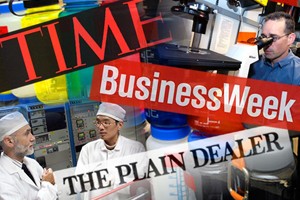
UC Research Racks Up New National Headlines
The University of Cincinnati stands among the nations top research universities in the United States, according to the National Science Foundation.
In addition, The Chronicle of Higher Education lists the university in the most prestigious very high category in terms of research activity as reported by the Carnegie Foundation.
Thats not all. Month after month, UC routinely makes the roster of universities earning the best of research headlines from the national media. March 2008 is just another case in point, with the university gaining headlines and coverage from
- ABCs 20/20
- Associated Press
- BusinessWeek
- CNN.com
- Forbes
- Popular Science
- TIME
- United Press International
And UC researchers were also featured in prestigious international specialty outlets, national dailies and regional news media, including News-Medical.net (Australia), Health.com, MedPage Today, the Boston Herald, the San Diego Union-Tribune, Chicagos Daily Herald, the Baltimore Sun, Clevelands The Plain Dealer, the Columbus Dispatch and the Dayton Daily News.
Following is a selection that recaps the research recognition received by UC in the last month.
- ABCs 20/20 featured the audiology research of Pete Scheifele, associate professor of communication sciences and disorders, who studies topics such as hearing in animals and aquarium acoustics.
- The Associated Press wire service provided mention of research by Gary Powell, adjunct associate professor of organizational leadership, related to Powells study of problems connected to college hazing.
- BusinessWeek and Popular Science featured research by Ohio Eminent Scholar Andrew Steckl, professor of electrical and computer engineering, who found a way to use salmon sperm (a common refuse material in the fishing industry which disposes of tons of salmon sperm annually because it spoils the taste of the fish) to boost the brightness of the organic light-emitting diodes used in cell phones, PDAs and some TVs by a ten-fold margin.
- Forbes just ranked Americas cleanest cities, and the water-cleanliness rankings were derived from statistics compiled by UC using local reports of Environmental Protection Agency violations.
- TIME magazine featured research by Scott Belcher, associate professor of pharmacology and cell biophysics, related to contaminants released when hot liquids are poured into plastic bottles and containers.
- United Press International and other outlets like Occupational Hazards and The Daily Green, an environmental news Web site, featured research by James Lockey, professor of environmental health, that found workers who were once exposed to low levels of vermiculite, an asbestos-like mineral commonly used as an ingredient in potting soil and landscaping products, are at an increased risk for lung cancer.
In addition, UC pediatrics research resulting in a simple laboratory test to provide doctors a way to identify patients at risk of developing acute kidney failure after surgery was reported by News-Medical.net in Australia and in the Clinical Journal of the American Society of Nephrology.
Political polling by UCs Institute for Policy Research was praised by The Columbus Dispatch for its accuracy. The paper noted that UCs Ohio Poll came within one point of the actual margin of victory for Hillary Clinton in Ohio and that the poll has accurately projected the winner in every contest it has polled since 1994. Clevelands The Plain Dealer also turned to Eric Rademacher, co-director of the Ohio Poll, for his research expertise.
Other UC research making news included a study linking obesity to decreased productivity at work and research related to taxes and mortgages, as well as stroke research.
- See UCs February 2008 research headlines.
- See UCs January 2008 research headlines.
- Read more about UCs 2007 research headlines.
- Read details from UCs latest research funding report.
- Get the latest news from UC.
Related Stories
Ancient Maya blessed their ballcourts
April 26, 2024
Using environmental DNA analysis, researchers identified a collection of plants used in ceremonial rituals in the ancient Maya city of Yaxnohcah. The plants, known for their religious associations and medicinal properties, were discovered beneath a plaza floor upon which a ballcourt was built, suggesting the building might have been blessed or consecrated during construction.
OTR mural centerpiece of 'big' celebration of UC alumni
April 26, 2024
New downtown artwork salutes 18 alumni award recipients who personify UC’s alumni success.
2024 Daniel Drake Medals to be awarded April 27
April 24, 2024
The UC College of Medicine will award three people with 2024 Daniel Drake Medals April 27.
